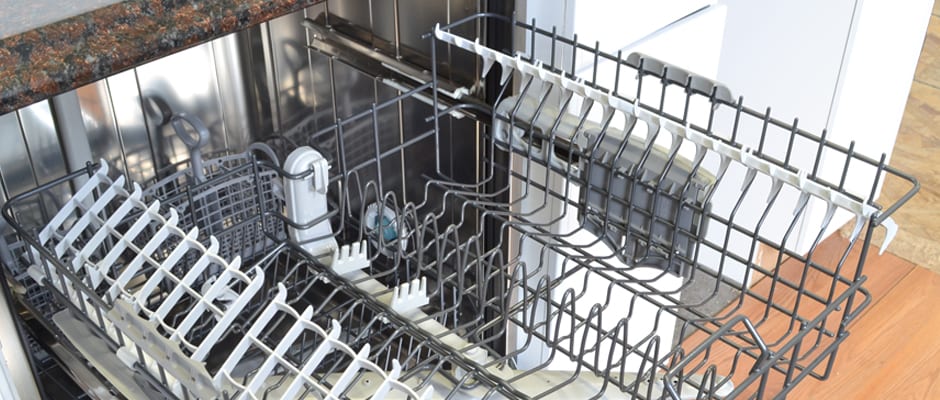Pros
Cons
Introduction
Recently, a team of Spanish manufacturers attempted to recreate “dishwasher,” but their efforts were met with abject failure. Not only did their machine fail to even approach the glory that was the Martian dishwasher, it also failed to live up to consumer standards. This is that dishwasher.
Front
{{section_header}}{{section.name}}{{/section_header}}
The front is one of the {{product.model}}’s few attractive design elements. The stainless steel, angular handle and lack of frontal controls offer a tasteful display for most kitchens—traditional or modern. The {{product.brand.name}} logo on the bottom of the door looks a bit tacky, though, and some consumers may be wary of the conspicuously thin door.
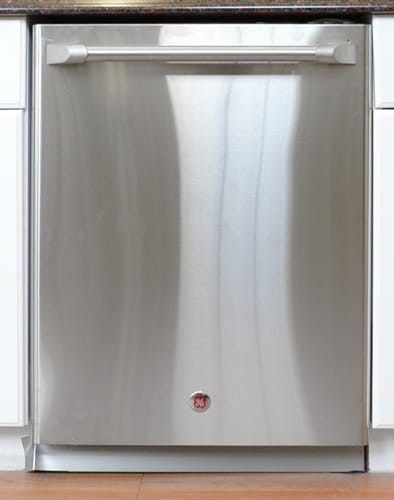
The front of the GE CDWT980VSS.
Finish
{{section_header}}{{section.name}}{{/section_header}}
The {{product.model}}’s stainless steel finish is smooth to the touch but appears dark in certain light.

Controls
{{section_header}}{{section.name}}{{/section_header}}
We spent several days thinking of the best word to describe the control panel, and this is what we came up with: “nonsensical.” Clearly, {{product.brand.name}} is interested in alien technology, because the cycle symbols are as intelligible as Mayan hieroglyphs. We tried to decipher them and came up with some sort of message involving the Kennedy assassination and a Nevada moon landing simulation. But we didn’t pay that any attention because we’re in the business of reviewing dishwashers.
Seriously, though, the symbols are counter-intuitive to the point of being silly, and they’re not even labeled, meaning you’ll need to consult the equally vague, grammatically offensive instruction manual to figure out what they mean. Sure, the approximate temperatures are labeled for you, but {{product.brand.name}} should know that heat does not in itself satisfy all washing demands.
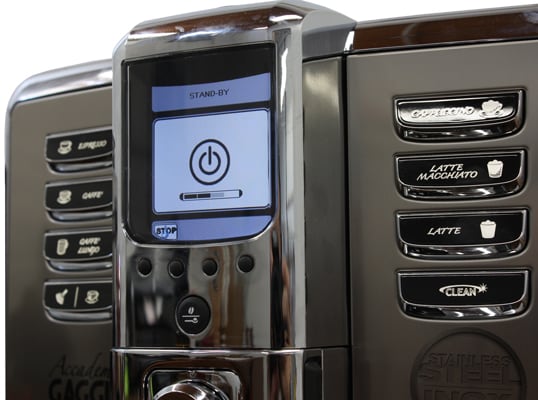
Interior
{{section_header}}{{section.name}}{{/section_header}}
The wash tub is made of a highly reflective stainless steel, which looks nice and also helps in the drying process.
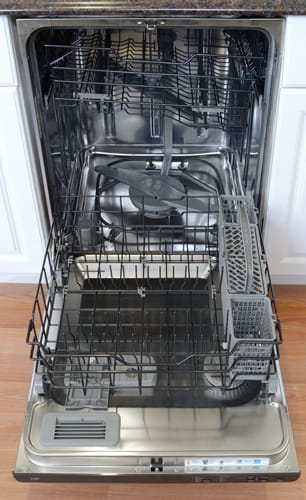
The CDWT980VSS with door open.
Top Rack
{{section_header}}{{section.name}}{{/section_header}}
Like the control panel, both of the dish racks are somewhat counter-intuitively designed. The tines and threads are spaced in a way that limits flexibility, and the foldable cutlery holders only seemed to get in the way, even when locked in place. We appreciated the handle and the relatively sturdy feel, but the overall layout made it easy for dishes to slide around and give you a headache.
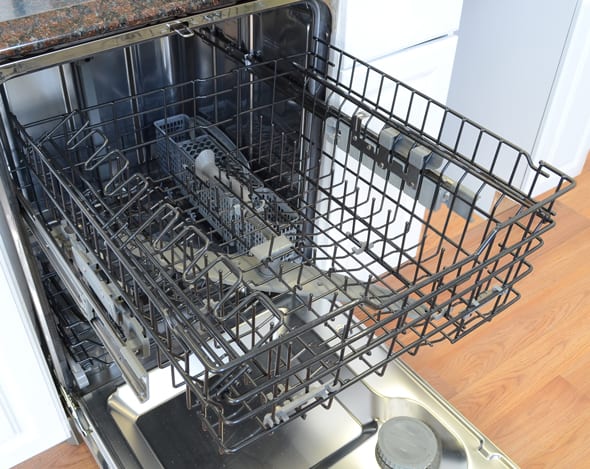
The top rack of the CDWT980VSS.
Bottom Rack
{{section_header}}{{section.name}}{{/section_header}}
The bottom rack has four rows of tines, two of which are collapsible. The threads were spaced about in something of a hodgepodge, making it difficult to load smaller dishes. The foldable rows also seemed a bit flimsy.
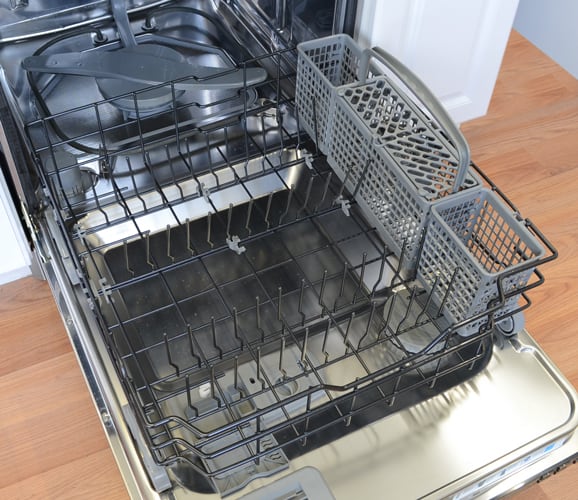
The bottom rack of the CDWT980VSS.
Cutlery Basket
{{section_header}}{{section.name}}{{/section_header}}
The cutlery basket is designed as if {{product.brand.name}} forgot to make one, so they ran to the nearest Wal-Mart, bought the first basket they could find and threw it in. Seriously, WTF? It doesn’t even fit... like, at all. There’s an empty space in the bottom rack that looks like the intended place for some sort of cutlery basket, but not this one.
Oh, but wait! There’s two of them! So, you know, like, stop complaining, Americans. Quantity over quality right?
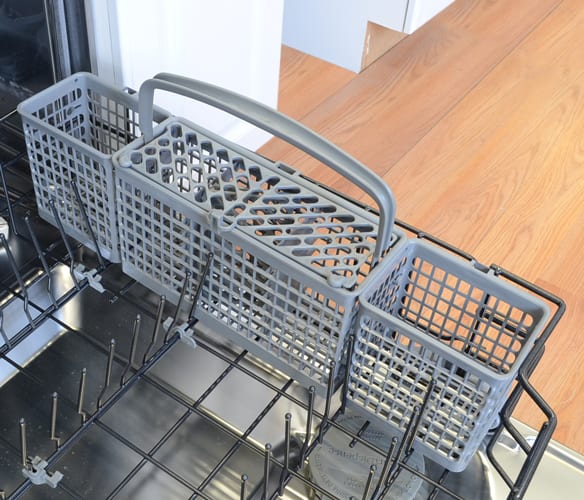
The CDWT980VSS cutlery basket.
Electricity Use
{{section_header}}{{section.name}}{{/section_header}}
Power usage was pretty average, with the main cycles consuming between 0.6 and 1.3 kWh—not great, but not bad. This made for an electricity cost that ranged from 6 to 14 cents per wash. Much of this energy is used to heat water to considerably high wash temperatures.
{{ attachments(510c263991c39b74d5000450)
Water Use
{{section_header}}{{section.name}}{{/section_header}}
This is where the {{product.model}} was truly efficient; it barely used any water. More importantly, the volume of water was fairly consistent across all wash cycles. From the Quick Wash to the Super Intensive Cycle, the machine consumed 2.21 to 3.1 gallons of cold water. This averages out to a water cost of just 1 cent per wash, which is very good.
We should mention, however, that Fagor doesn't seem to get the difference between a hot and cold water connection. Or maybe they do and just didn't think to, you know, tell... anyone. Because the installation manual was mum on this, we had to call the Fagor customer service hotline, which was met with this reassuring answer: "Uh, cold water? I think it was cold... Yeah, cold water..." Gee, thanks!
Yearly Running Cost
{{section_header}}{{section.name}}{{/section_header}}
Congratulations, {{product.brand.name}}, you did it! You made an efficient dishwasher, even if it does little more than save you on your utility bill. Based on an average of using the Normal cycle 50 percent of the time, the {{product.model}} will cost roughly $24.40 a year to operate. This is very impressive considering how hot this machine gets.
{{ attachments(50fc5209bd0286e39e00082d)
Washing Speed
{{section_header}}{{section.name}}{{/section_header}}
Okay, the {{product.model}} is a fairly quick machine—likely a testament to its efficiency. The Quick Wash clocked in at a mere 53 minutes, while the Normal cycle took roughly an hour-and-a-half, and the Super Intensive an hour and forty minutes. But, as you’ll see, this speed was reflected in its performance.
{{ attachments(510c2b8dc94fa2cf0f00047a)
Washing Performance
{{section_header}}{{section.name}}{{/section_header}}
“Disgusting.” That’s what we thought each time we opened this dishwasher after a load was complete, with the exception of the Normal cycle—the one redeemable aspect of the {{product.name}}'s wash performance.
We must admit, though, all three cycle performed very well on our egg tests, in which we bake egg batter onto spoons. This is likely due to the high temperatures the {{product.model}} manages to reach. (Proteins are more susceptible to high temperature rinsing than detergents.) However, this can eventually become a concern, as really high temperatures can cause glass etching over time.
{{ attachments(50fc5204bd0286f12a0007dd)
Quick Wash Cycle
{{section_header}}{{section.name}}{{/section_header}}
The Quick Wash is all quick and no wash. If you’re okay with manually scrubbing your dishes after each wash then full speed ahead! But if you’re a human being who likes to buy appliances that actually work then you’ll probably loathe this wash cycle. To be fair, we haven’t come across many dishwashers with a high-performing Quick Cycle, but given our list of grievances with this machine it’s difficult to find forgiveness.
{{ attachments(50fc5204bd02860f5a0007e0)
Normal Wash Cycle
{{section_header}}{{section.name}}{{/section_header}}
The Normal cycle performed well. Really, it did. No joke. It even did well on our strenuous lipstick test, in which we dab a coffee mug with glossy lipstick. There was no particle spattering, and even the dishes that were not completely clean were basically “good enough.”
In fact, considering the {{product.model}}’s abysmal companion cycles, the Normal wash was a bit… too good, drawing our suspicions that this machine really was designed by Spanish scientists trying to replicate alien technology. That would explain the inconsistency, and the odd little icons on the control panel. It all makes so much sense now!
Normal Cycle
{{ attachments(510c3bcb91c39b74d5000743)
Heavy/Pots & Pans Wash Cycle
{{section_header}}{{section.name}}{{/section_header}}
Food particles. Everywhere. If the numbers don’t point out how terribly this cycle performed it’s because it sprayed tiny bits of spinach and oatmeal and tomato sauce throughout the entire wash load. Then, when the dry cycle engaged, all these tiny new stains baked onto the dishes and created a massive headache for everyone involved. Each dish, including the clean dishes that get loaded alongside the dirty ones, needed to be washed by hand afterward. It was just the worst. And this was the so-called Super Intensive (and beyond!) wash.
Pots & Pans Cycle
{{ attachments(50fc5204bd02862aee0007e1)
Washing Cycles
{{section_header}}{{section.name}}{{/section_header}}
Aside from the three basic cycles—Quick Wash, Normal, and Super Intensive—the {{product.model}} includes an intensive wash (which we assume is somewhere in the ethereal void between Normal and Super Intensive) and an Economy wash. We found the Normal cycle to be far and away the best performer. While both the Intensive and Super Intensive cycles got very hot (153.9 and 158.2 degrees, respectively), they simply couldn’t handle heavily soiled dishes; they really just served to stain our dishes with tiny specks of food. It was curious, however, that the Normal wash performed well—very well. And this is what the {{product.model}} boils down to: It gets super hot, but {{product.brand.name}} wrongly assumes that heat is all you need to clean dishes. It really just lacks when it comes to other key areas of performance, such as intensity, spray agitation, and filtration.
As for the extra cycles, the Economy wash was indeed economical, costing a mere 8 cents per wash (compared to 15 cents on the Super Intensive). But given that it failed to reach 150 degrees in peak temperature suggests it won’t even benefit from the {{product.model}}’s one perk, which is super hot water.
Customization
{{section_header}}{{section.name}}{{/section_header}}
No customization here. Some of the cycles reach a high enough temperature to kill bacteria, thereby negating the need for a sanitize option, but there’s still no way to customize individual wash loads.
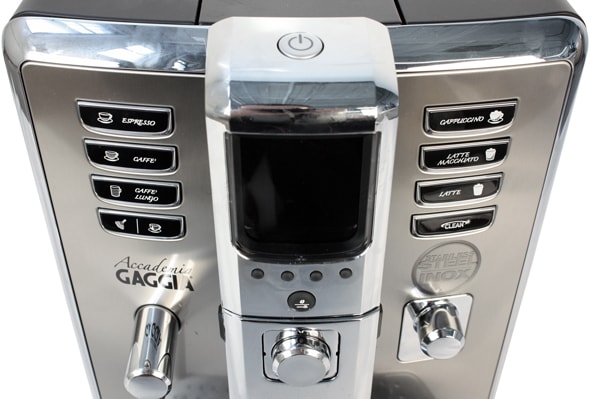
Additional Wash Options
{{section_header}}{{section.name}}{{/section_header}}
The {{product.model}} includes a few extra wash options: an individual rack wash, a rinse cycle, and a delay of three, six or nine hours. But good luck deciphering which feature corresponds to which cryptic diagram.

Capacity
{{section_header}}{{section.name}}{{/section_header}}
We were able to fit 10 place settings, including a serving setting. This is pretty standard, and should be enough for most home dishwashing needs.

Top Rack
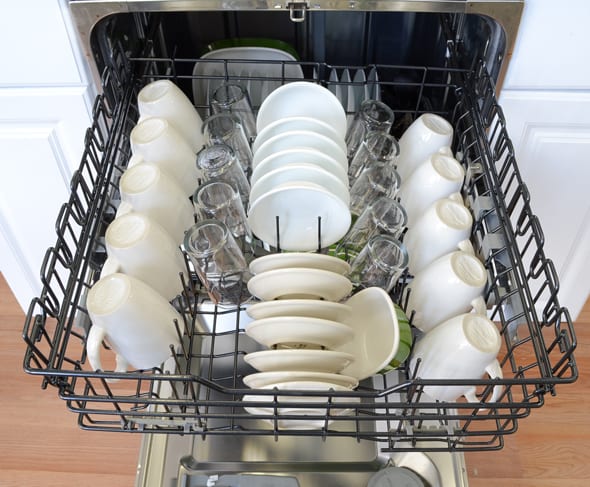
Bottom Rack
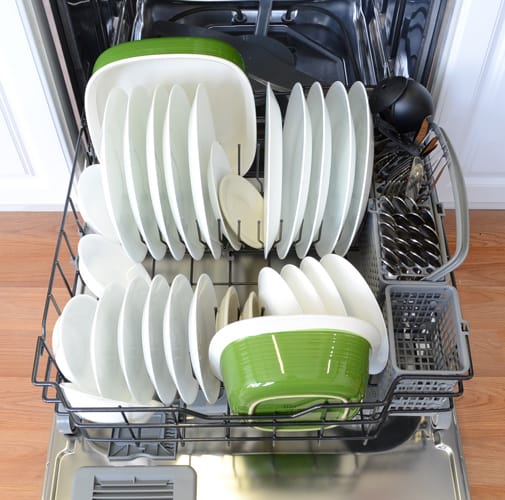
Wash Arms & Filters
{{section_header}}{{section.name}}{{/section_header}}
The narrow wash arms, located beneath each rack, are made of a flimsy plastic, but they seem sturdy enough to last a while. We suspect a home installation may differ from our tests in some respects, but we found it necessary to clean out the filter after each wash. The {{product.model}} includes a contraption that prevents operation when the drain hose is full (or close to full). Frustratingly, there’s no way to electronically command the machine to drain, which meant we had to do it manually. Ew…
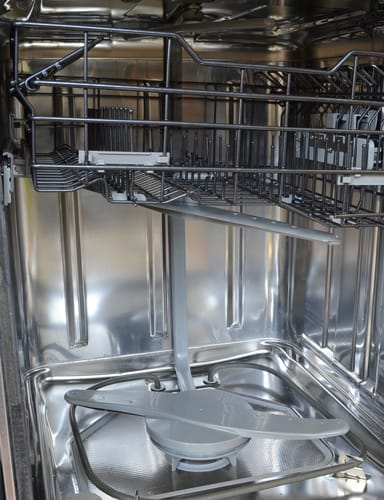
The CDWT980VSS wash arms.
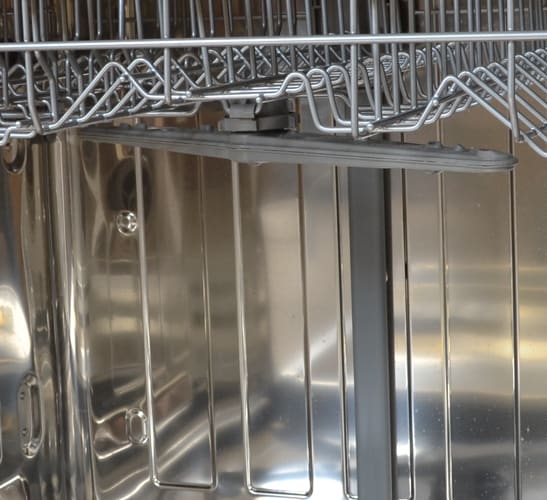
The DW 14140 upper wash arm
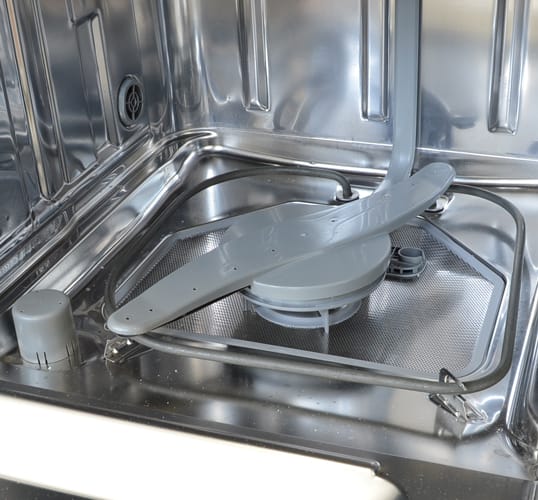
The CDWT980VSS filter.
Lower Dish Rack
{{section_header}}{{section.name}}{{/section_header}}
The space between spindles in the lower rack is pretty large, making it difficult to load smaller dishes. This definitely limited its flexibility, but the two foldable rows of tines helped compensate.

The bottom rack of the CDWT980VSS.
Upper Dish Rack
{{section_header}}{{section.name}}{{/section_header}}
We found the layout of the top rack to be somewhat challenging for loading large amounts of dishware. There is only one row of tines (if you consider arcs to be tines), meaning glasses and dishware tend to slosh around when maneuvering the rack aggressively. Really, {{product.brand.name}}, just install some tines. They’re popular for a reason.

The top rack of the CDWT980VSS.
Cutlery Holder
{{section_header}}{{section.name}}{{/section_header}}
There are two of them! Yay! We actually found this useful when filling larger dish loads, but for some terrible reason the baskets don’t actually fit into any specific location; they just sort of slide around all willy-nilly like in the lower rack. This gets to the heart of our frustration with the {{product.model}}: Every time we found something we liked it was immediately checked by some silly little blemish that could easily have been avoided.

The CDWT980VSS cutlery basket.
Detergent Dispenser
{{section_header}}{{section.name}}{{/section_header}}
We’re yet to come across a detergent dispenser that really knocks our socks off. We’re also yet to come across one that drastically disappoints us. Despite the {{product.model}}’s attempts to frustrate, it didn’t do so with the detergent dispenser; it’s pretty basic.
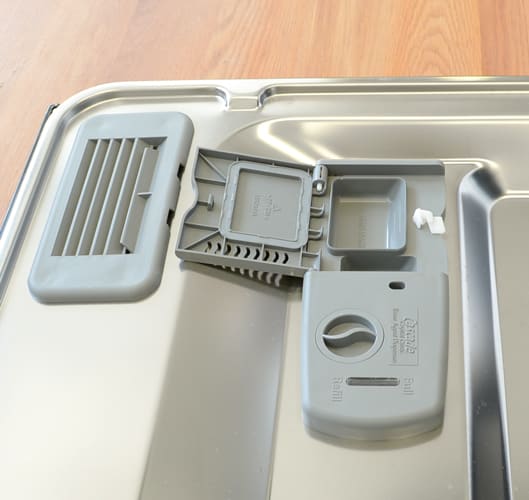
The CDWT980VSS detergent dispenser.
Ease of Use
{{section_header}}{{section.name}}{{/section_header}}
We can’t imagine a scenario where someone would be reduced to an invalid trying to operate this machine, but for folks who don’t feel like unearthing the Rosetta Stone in order to decrypt their dishwasher’s control panel, the {{product.model}} may prove frustrating. The racks and dispenser and everything are straightforward; it’s just that control panel that we found so darn silly.
Noise
{{section_header}}{{section.name}}{{/section_header}}
The {{product.model}} is pretty standard in the noise department; it doesn’t disturb but it doesn’t impress either. It shouldn’t be a problem for noise zealots.
Controls
{{section_header}}{{section.name}}{{/section_header}}
This was one of our biggest beefs. Selecting wash cycles and options is easy enough, but you have to consult the darn manual just to figure out what each button means. And don’t even begin to tell us that these symbols are intuitive. The Intensive and Super Intensive diagrams look like some sort of serpent carrying a basket on its back, the Normal wash looks like the astrological symbol for Aquarius, and the Quick Wash looks like a smiley face with creepy arrows for eyes.


Efficiency
{{section_header}}{{section.name}}{{/section_header}}
This is the only place where the {{product.model}} shined. It’s definitely a highly efficient dishwasher, mainly in terms of its water consumption (which barely exceeded 3 gallons per wash in the heaviest cycle). There’s also an Economy wash, but it’s overall sustainability level should satisfy most energy demands.
Washing Performance
{{section_header}}{{section.name}}{{/section_header}}
This is where the {{product.model}} really tanked. The Normal wash good—very good—but beyond that this dishwasher performed dismally. Its high temperatures ensured strong performance on proteins such as egg and meat, but it didn’t do a very good job of actually removing stains, which is what a dishwasher is supposed to do, right?
Features
{{section_header}}{{section.name}}{{/section_header}}
There are a few extra features but nothing to write home about. There’s the standard delay and rinse options, and on some cycles the water gets hot enough to sanitize. Once again, though, we were very displeased with the control panel; it’s replete with cryptic symbols that require you to either consult the manual or commit them to memory, neither of which should be asked of a consumer.
Meet the tester
Tyler Wells Lynch is a freelance writer and journalist whose work has appeared in Vice, Wirecutter, Gizmodo, The Rumpus, Yes!, and the Huffington Post, among others. He lives in Maine.
Checking our work.
Our team is here to help you buy the best stuff and love what you own. Our writers, editors, and experts obsess over the products we cover to make sure you're confident and satisfied. Have a different opinion about something we recommend? Email us and we'll compare notes.
Shoot us an email